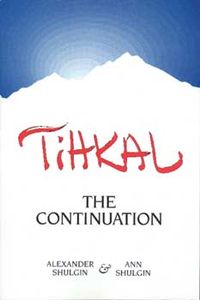- TiHKAL
-
TiHKAL: The Continuation 
Cover of TiHKAL, 1st ed.Author(s) Alexander and Ann Shulgin Country United States Subject(s) Pharmacology, Autobiography, Psychedelic drugs Publisher Transform Press Publication date 1997 Media type Paperback Pages xxviii, 804 p. ISBN 0-9630096-9-9 OCLC Number 38503252 Preceded by PiHKAL Not to be confused with Tical.TiHKAL: The Continuation is a 1997 book written by Alexander Shulgin and Ann Shulgin about a family of psychoactive drugs known as tryptamines. A sequel to PiHKAL: A Chemical Love Story, TiHKAL is an acronym that stands for 'Tryptamines I Have Known and Loved'.
Contents
Content
TiHKAL, much like its predecessor PiHKAL, is divided into two parts. The first part, for which all rights are reserved, begins with a fictionalized autobiography, continuing where the similar section of PiHKAL left off; it then continues with a collection of essays on topics ranging from psychotherapy and the Jungian mind to the prevalence of DMT in nature, ayahuasca and the War on Drugs. The second part of TiHKAL, which may be conditionally distributed for non-commercial reproduction (see external links below), is a detailed synthesis manual for 55 psychedelic compounds (many discovered by Alexander Shulgin himself), including their chemical structures, dosage recommendations, and qualitative comments.
Like PiHKAL, the Shulgins were motivated to release the synthesis information as a way to protect the public's access to information about psychedelic compounds, a goal Alexander Shulgin has noted many times.[1] Following a raid of his laboratory in 1994 by the United States DEA,[2] Richard Meyer, spokesman for DEA's San Francisco Field Division, stated that "It is our opinion that those books [referring to the previous work, PiHKAL] are pretty much cookbooks on how to make illegal drugs. Agents tell me that in clandestine labs that they have raided, they have found copies of those books."
Tryptamines Listed
Substance Chemical name 1 AL-LAD 6-Allyl-N,N-diethyl-NL 2 DBT N,N-Dibutyl-T 3 DET N,N-Diethyl-T 4 DiPT N,N-Diisopropyl-T 5 alpha,O-DMS 5-Methyoxy-alpha-methyl-T 6 DMT N,N-Dimethyl-T 7 2,alpha-DMT 2,alpha-Dimethyl-T 8 alpha,N-DMT alpha,N-Dimethyl-T 9 DPT N,N-Dipropyl-T 10 EiPT N-Ethyl-N-isopropyl-T 11 AET alpha-Ethyl-T 12 ETH-LAD 6,N,N-Triethyl-NL 13 Harmaline 3,4-Dihydro-7-methoxy-1-methyl-C 14 Harmine 7-Methyoxy-1-methyl-C 15 4-HO-DBT N,N-Dibutyl-4-hydroxy-T 16 4-HO-DET N,N-Diethyl-4-hydroxy-T 17 4-HO-DiPT N,N-Diisopropyl-4-hydroxy-T 18 4-HO-DMT N,N-Dimethyl-4-hydroxy-T 19 5-HO-DMT N,N-Dimethyl-5-hydroxy-T 20 4-HO-DPT N,N-Dipropyl-4-hydroxy-T 21 4-HO-MET N-Ethyl-4-hydroxy-N-methyl-T 22 4-HO-MiPT 4-Hydroxy-N-isopropyl-N-methyl-T 23 4-HO-MPT 4-Hydroxy-N-methyl-N-propyl-T 24 4-HO-pyr-T 4-Hydroxy-N,N-tetramethylene-T 25 Ibogaine A complexly substituted-T 26 LSD N,N-Diethyl-L 27 MBT N-Butyl-N-methyl-T 28 4,5-MDO-DiPT N,N-Diisopropyl-4,5-methylenedioxy-T 29 5,6-MDO-DiPT N,N-Diisopropyl-5,6-methylenedioxy-T 30 4,5-MDO-DMT N,N-Dimethyl-4,5-methylenedioxy-T 31 5,6-MDO-DMT N,N-Dimethyl-5,6-methylenedioxy-T 32 5,6-MDO-MiPT N-Isopropyl-N-methyl-5,6-methylenedioxy-T 33 2-Me-DET N,N-Diethyl-2-methyl-T 34 2-Me-DMT 2,N,N-Trimethyl-T 35 Melatonin N-Acetyl-5-methoxy-T 36 5-MeO-DET N,N-Diethyl-5-methoxy-T 37 5-MeO-DiPT N,N-Diisopropyl-5-methoxy-T 38 5-MeO-DMT 5-Methoxy-N,N-dimethyl-T 39 4-MeO-MiPT N-Isopropyl-4-methoxy-N-methyl-T 40 5-MeO-MiPT N-Isopropyl-5-methoxy-N-methyl-T 41 5,6-MeO-MiPT 5,6-Dimethoxy-N-isopropyl-N-methyl-T 42 5-MeO-NMT 5-Methoxy-N-methyl-T 43 5-MeO-pyr-T 5-Methoxy-N,N-tetramethylene-T 44 6-MeO-THH 6-Methoxy-1-methyl-1,2,3,4-tetrahydro-C 45 5-MeO-TMT 5-Methoxy-2,N,N-trimethyl-T 46 5-MeS-DMT N,N-Dimethyl-5-methylthio-T 47 MiPT N-Isopropyl-N-methyl-T 48 alpha-MT alpha-Methyl-T 49 NET N-Ethyl-T 50 NMT N-Methyl-T 51 PRO-LAD 6-Propyl-NL 52 pyr-T N,N-Tetramethylene-T 53 T Tryptamine 54 Tetrahydroharmine 7-Methoxy-1-methyl-1,2,3,4-tetrahydro-C 55 alpha,N,O-TMS alpha,N-Dimethyl-5-methoxy-T See also
- PiHKAL, the 1991 book by the same authors, on phenethylamines.
Notes
- ^ Bennett, Drake (2005-01-30). "Dr. Ecstasy". New York Times Magazine (New York Times). http://www.nytimes.com/2005/01/30/magazine/30ECSTASY.html. Retrieved 2006-07-08.
- ^ "DEA Raid of Shulgin's Laboratory". Erowid. 2004-01-08. http://www.erowid.org/culture/characters/shulgin_alexander/shulgin_alexander_raid.shtml. Retrieved 2006-07-08.
External links
- Erowid Online Books: "TiHKAL: The Continuation" by Alexander & Ann Shulgin
- TiHKAL • info A visual index and map of TiHKAL, including the formatted text of Book II. Includes over 300 corrections to the original HTML version.
Drugs from TiHKAL AL-LAD • DBT • DET • DiPT • 5-MeO-α-MT • DMT • 2,α-DMT • α,N-DMT • DPT • EiPT • α-ET • ETH-LAD • Harmaline • Harmine • 4-HO-DBT • 4-HO-DET • 4-HO-DiPT • 4-HO-DMT • 5-HO-DMT • 4-HO-DPT • 4-HO-MET • 4-HO-MiPT • 4-HO-MPT • 4-HO-pyr-T • Ibogaine • LSD • MBT • 4,5-MDO-DiPT • 5,6-MDO-DiPT • 4,5-MDO-DMT • 5,6-MDO-DMT • 5,6-MDO-MiPT • 2-Me-DET • 2-Me-DMT • Melatonin • 5-MeO-DET • 5-MeO-DiPT • 5-MeO-DMT • 4-MeO-MiPT • 5-MeO-MiPT • 5,6-MeO-MiPT • 5-MeO-NMT • 5-MeO-pyr-T • 6-MeO-THH • 5-MeO-TMT • 5-MeS-DMT • MiPT • α-MT • NET • NMT • PRO-LAD • pyr-T • Tryptamine • Tetrahydroharmine • α,N,O-TMS
Categories:- Psychedelic tryptamines
- Psychedelic research
- 1997 books
- Science books
- Psychedelic literature
Wikimedia Foundation. 2010.
